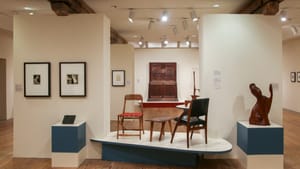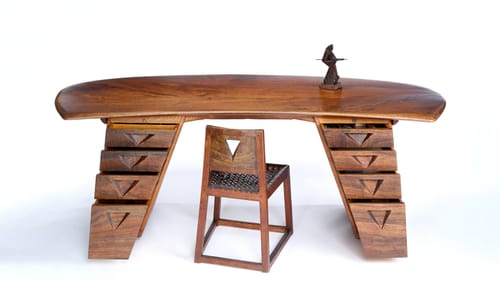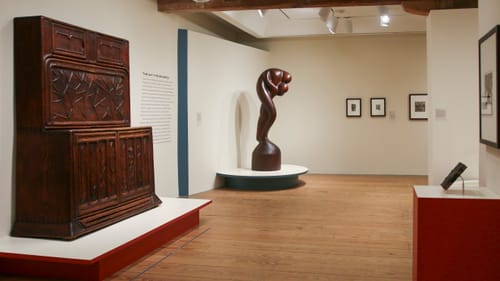Stay in the Loop
BSR publishes on a weekly schedule, with an email newsletter every Wednesday and Thursday morning. There’s no paywall, and subscribing is always free.
A rare gallery glimpse of iconic woodworks
Brandywine Museum of Art presents The Crafted World of Wharton Esherick

Now on view at the Brandywine Museum of Art is an elegant, uplifting look into the creativity of the man called the father of the Studio Furniture Movement. Aptly titled The Crafted World of Wharton Esherick, the exhibition—while not a retrospective—displays 70 works created over the artist’s entire career.
Esherick (1887-1970) was born in Philadelphia and determined at an early age to be an artist. He studied metalsmithing, drawing, and printmaking at the Pennsylvania Academy of the Fine Arts, learning from William Merritt Chase and others, and like many artists of the era, embarked on a (not entirely successful) career as an illustrator. After he married, Esherick and his wife Letty settled around 1915 in a farmhouse on Valley Forge Mountain that they called Sunekrest (pronounced “sunny crest”). They were homesteaders and proponents of “back to the land;” Letty ran the farm while Esherick (like Thoreau, whom he admired) devoted himself full-time to art.
Art and function
Works in this beautiful exhibition trace the arc and span of Esherick’s multimedia artistic interests and the ways in which he applied his artistry to functional objects. There are drawings, paintings, prints (mostly woodblocks, not surprisingly), and of course his works created in wood. His furniture is especially strikingly displayed, often seeming to float in the gallery’s open spaces. The Crafted World is arranged around four curatorial “thinking points”—Rural and Urban, Pattern Recognition, Bodies in Space, and The Way Things Grow—that intertwine chronologically and spatially throughout.
Though he left the world of commercial illustration, the artist continued to illustrate art books for Philadelphia’s Centaur Press. These include beautiful woodblock prints like The Solid Forest and Forger at his Forge (both 1924), both created to illustrate Walt Whitman’s Song of the Broad-Axe, and Of a Great City (1928), showing writer Theodore Dreiser at his desk.

On view is Esherick’s own Flat Top Desk, one of his most striking and well-known works, crafted of walnut and padauk (a reddish African wood). Made in 1929 (with its matching chair) and updated in 1962, it was not made for display. Esherick used this desk all his life, and yet like many of his creations, it transcends its utilitarian purpose, a great work of design and creation.
Pattern and movement
The artist was deeply cognizant of natural and manufactured patterns and utilized them in clever and creative ways. For his painting Moonlight on Alabama Pines (1919-1920), he created a frame that repeats the painting’s imagery, blurring boundaries between frame and image and showing his first forays into engaging with wood. The Race (1925) is a small painted wooden sculpture that makes pattern itself become three-dimensional.
Throughout are drawings that show his preoccupation with movement in space, and among the photographs of Esherick on view is one taken by Emil Luks (c. 1934) showing the artist next to one of his most remarkable works, Oblivion. This monumental wooden sculpture, carved from a solid block of walnut, stands over six feet tall, its mass balanced by an eloquent sense of movement. In Esherick’s studio, it lives in the corner where the artist placed it. But here, like other works transplanted to this exhibition, it can be clearly viewed in its totality.
Creative use and re-use
The Crafted World is filled with treasures large and small. Esherick designed and created his huge pattern-embossed Drop Leaf Desk (1927), made of red oak and tooled leather, for storing his prints. The striking S-K Chair (1957) of walnut and black Naugahyde is perfectly mid-century modern. There are several charming stair models, including one made in 1934 for a staircase in the lobby of Hedgerow Theatre in Media, Pennsylvania.

Esherick engaged in creative re-use before it was prevalent, as his witty Wagon Wheel Chair (1931) and Hammer Handle Chair (1938) attest. And smaller works have anthropomorphic personalities. The cherry Library Ladder (1969), perhaps inspired by a 1929 Dance Sketch, feels as though it’s reaching for a book. The Double Music Stand (1962) was made for a flute duo, and the 1960 Music Stand, which was created for a cellist, echoes the player’s fluid bowing movements. There’s even a tiny four-inch cast-aluminum Light Pull (1930) suspended in space that invites you to turn on a lamp. Because these practical items were created to be used, their tactile qualities are often overpowering, creating a tantalizing urge to sit, to write, to hold, to touch.
The whole Esherick oeuvre
After Esherick died, his family founded the Wharton Esherick Museum (WEM) in 1972. There, more than 3,000 objects are held in several remarkable buildings that the artist called his “autobiography in three dimensions,” including one designed in 1956 in conjunction with Louis Kahn. Works at WEM are displayed in situ, arranged largely as the artist—who lived and worked in the spaces—left them. While items have been loaned previously, The Crafted World is the first exhibition of this scope, and many works on view have never before left their original home.
Brandywine curator Amanda Burdan had originally planned to mount a small exhibition of Esherick’s prints, but after several years of planning, she and WEM curator Emily Zilber decided to enlarge the scope to encompass his entire oeuvre. An illustrated catalog accompanies The Crafted World, which runs through Sunday, January 19, 2025. It will then travel to the Chazen Museum of Art (Madison, Wisconsin) and the Taft Museum of Art (Cincinnati, Ohio). And when they return to the WEM campus, these iconic Esherick works are not likely to leave their home again for the foreseeable future.
What, When, Where
The Crafted World of Wharton Esherick. $8-$20. Through January 19, 2025, at the Brandywine Museum of Art, 1 Hoffman’s Mill Road, Chadds Ford. (610) 388-2700 or brandywine.org.
Accessibility
The entire museum (including the Millstone Café) is wheelchair accessible, with accessible parking, barrier-free entrance, and available wheelchairs. Service animals are welcome.
Sign up for our newsletter
All of the week's new articles, all in one place. Sign up for the free weekly BSR newsletters, and don't miss a conversation.

 Gail Obenreder
Gail Obenreder